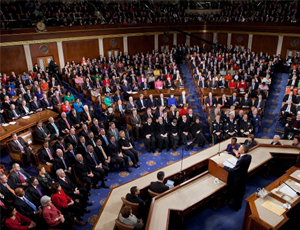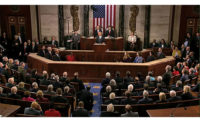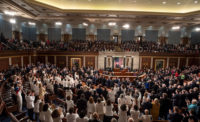
President Obama's State of the Union address included a further pitch for increased federal infrastructure spending, which he proposed to finance through savings gained from the military’s pullout from Iraq and pulling back from the Afghanistan war.
Obama can take action on some of the many items he discussed in his Jan. 24 speech through executive orders or other administrative moves. But many of the proposals would require approval on Capitol Hill, where they are likely to face a rough path.
For construction, a key part of the president’s address was the boost he proposed for transportation infrastructure spending. But Obama had floated similar proposals in his fiscal 2012 budget request in February 2011 and again in his jobs bill last September, both times without much success.
Moreover, Obama’s new plan to use war-related savings to pay for infrastructure drew a blast from a top House Republican, though a construction union president praised the president’s idea.
Geoff Burr, Associated Builders and Contractors vice president of federal affairs, says, “There weren’t a lot of details, so it’s hard to say what would become reality.” Burr adds, “I think that a safe bet lately is always that practically none of it will.”
In his speech, Obama repeated a pro-public works refrain he has used in public comments over the past several months, declaring that the is a need to address the country's “crumbling roads and bridges.”
He reached back in history for examples of notable infrastructure developments, citing the construction of the Hoover Dam and Golden Gate Bridge during the Depression and the launch of the Interstate highway program in the 1950s.
To pay for new domestic projects, Obama had this recommendation: "Take the money we're no longer spending at war, use half of it to pay down our debt and use the rest to do some nation-building right here at home."
House Transportation and Infrastructure Committee Chairman John Mica (R-Fla.), said in response to Obama's speech: “America needs to rebuild its infrastructure but I do not support what appears to be the president’s plan to finance that effort by downsizing the military.”
House Republicans plan to help finance their long-term surface transportation bill in a different way—by tapping royalties from their proposed expansion of oil and gas drilling in the U.S. and offshore.
But Terry O’Sullivan, general president of the Laborers’ International Union of North America, praised Obama’s plan. O’Sullivan said, “We applaud his proposal to invest half of our nation’s ‘peace dividend’ in rebuilding America’s basic, critical infrastructure."
A White House background paper notes that the time frame for the infrastructure spending program would be six years.
Obama didn't specify how much savings he anticipates from winding down the Iraq and Afghanistan wars, but it would certainly be tens of billions of dollars.
The Congressional Budget Office, in a Jan. 31 report, outlined a troop-drawdown scenario that would produce an estimated $320 billion in deficit reduction over the five-year period from 2013 through 2017. That would be one year short of the six-year span the White House mentioned.
Taking half of the CBO-estmated savings for infrastructure, as Obama proposed, would yield an estimated $160 billion, or $32 billion per year for highways, bridges and other public-works programs.
In his address, Obama also said he would issue an executive order “clearing away the red tape that slows down too many construction projects.” Streamlining project reviews is part of a two-year highway bill that the Senate Environment and Public Works Committee cleared in November and is expected to be in the version Mica was to unveil on Jan. 31.
Construction and transportation groups welcomed Obama's State of the Union comments on infrastructure and took the opportunity to push for timely action on a new highway-transit bill.
The president didn't omit the buildings sector in his speech, and proposed "incentives" to companies "to upgrade their buildings" to make them more energy efficient.
Kateri Callahan, Alliance to Save Energy president, pointed to a bill introduced last year by Sens. Jeanne Shaheen (D-N.H.) and Rob Portman (R-Ohio) that aims to increase energy efficiency by working with states and other entities to modify building codes; helping states to set up revolving loans for manufacturers to improve their facilities’ energy efficiency, and other steps.
The Senate Energy and Natural Resources Committee cleared the measure last September, but there has been no further action yet.
On energy, Obama called for "an all-out, all-of-the above strategy," including expanded offshore drilling and developing U.S. natural gas reserves—though adding that he wants to require energy companies to disclose chemicals they use in gas extraction.
American Coalition for Clean Coal Electricity President Steve Miller said Obama’s speech “was most notable for what was left unsaid, namely any mention of coal—America’s dominant source of electricity—in the president’s plan for our nation’s energy future.”
The president also declared that he "will not walk away from the promise of clean energy," and urged approval of tax credits for that sector. On the other hand, he called for pulling back on tax breaks for oil companies.




Post a comment to this article
Report Abusive Comment